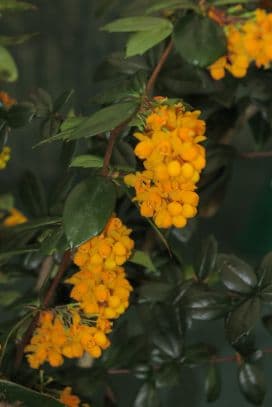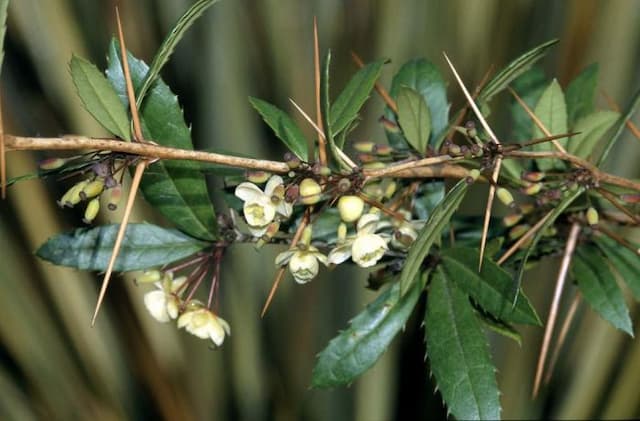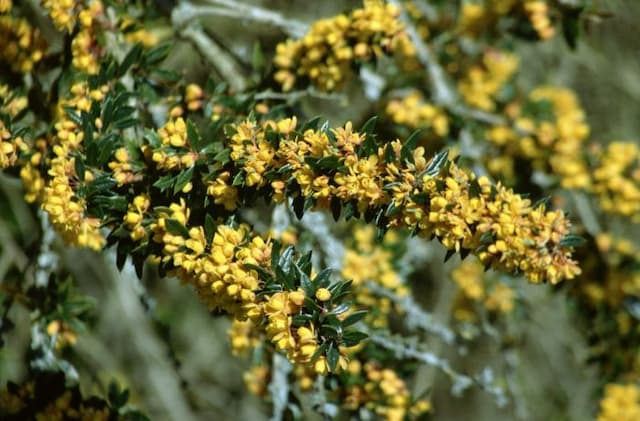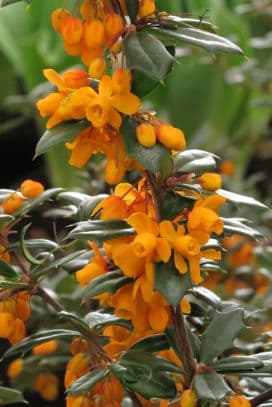Barrenwort Epimedium pinnatum

ABOUT
Epimedium pinnatum, commonly known as barrenwort, is a perennial plant valued for its ornamental appeal in shade gardens. It features heart-shaped leaves that emerge with a bronzy-red tint in spring, transitioning to a lush green as they mature. The foliage often retains its vibrancy throughout the growing season, offering aesthetic longevity. The barrenwort is well known for its distinctive flowers, which have a unique, delicate appearance. These blooms, typically present from mid to late spring, consist of bright yellow petals with inner sepals that are often spurred, lending them a whimsical, fairy-wing-like look. The blooms are carried in loose, open clusters that dance atop the foliage, attracting viewers with their nodding, lantern-like display. Barrenwort's leaves are not only attractive for their color but also for their intricate veining and slightly serrated edges, which give them a lacy texture. In some varieties, the leaves may turn reddish-bronze again in the fall, providing a second flush of color as the temperatures drop. Overall, barrenwort's charming flowers and attractive leaves make it a popular choice for gardeners looking to add textural and colorful interest to their shaded garden spaces. Its durability and low-maintenance nature further enhance its desirability as a garden plant.
About this plant
 Names
NamesFamily
Berberidaceae
Synonyms
Barrenwort, Bishop's Hat, Fairy Wings, Horny Goat Weed
Common names
Epimedium pinnatum subsp. colchicum, Epimedium pinnatum f. colchicum, Epimedium alpinum var. pinnatum, Epimedium macropterum var. colchicum.
 Toxicity
ToxicityTo humans
The plant known as "horny goat weed" has no significant toxicity reported in humans. General consumption as a herbal supplement is considered relatively safe if taken in appropriate amounts. However, there are not enough studies to conclusively determine if the ingestion of larger quantities could be harmful. Excessive consumption of any plant may lead to gastrointestinal discomfort or adverse reactions, particularly in individuals with sensitivities or pre-existing health conditions.
To pets
Horny goat weed does not appear to be highly toxic to pets, including dogs and cats. There is limited information available on its effects, but in general, pets are unlikely to consume large amounts of this plant. If a pet does ingest horny goat weed, they may possibly experience mild digestive upset. Always monitor your pet's health and consult a veterinarian if any unusual symptoms occur following ingestion of any plant material.
 Characteristics
CharacteristicsLife cycle
Perennials
Foliage type
Deciduous
Color of leaves
Varies
Flower color
Yellow
Height
1-2 feet (30-60 cm)
Spread
1-2 feet (30-60 cm)
Plant type
Herb
Hardiness zones
5
Native area
Turkey
Benefits
 General Benefits
General Benefits- Ground Cover: Epimedium pinnatum, also known as Barrenwort, is often used in gardens as a ground cover due to its spreading habit, which can create a dense carpet that suppresses weeds.
- Drought Tolerance: Once established, Barrenwort is quite drought-tolerant, making it suitable for dry shade gardens where other plants may struggle.
- Tolerates Various Soil Types: It can thrive in a range of soil conditions, from acidic to alkaline, which makes it versatile for different garden settings.
- Shade Tolerance: Barrenwort grows well in partial to full shade, offering a solution for landscaping in shady areas where sunlight is limited.
- Low Maintenance: This plant requires minimal maintenance once established, needing only occasional watering and little to no fertilizer.
- Attractive Foliage: The leaves of Barrenwort are often heart-shaped and have a delicate appearance, with some varieties displaying attractive mottling or marbling.
- Spring Blooms: It produces small, colorful flowers in the spring that can add a subtle yet beautiful touch to the garden.
- Deer and Rabbit Resistance: Barrenwort is not a preferred food source for deer and rabbits, which makes it an excellent choice for gardens plagued by these animals.
 Medical Properties
Medical Properties- Libido enhancement: Epimedium pinnatum is commonly called "horny goat weed" and is traditionally used to boost libido and sexual function.
- Erectile dysfunction: Compounds in the plant are believed to support erectile function by increasing blood flow to the genital area.
- Osteoporosis treatment: This plant has been used in traditional medicine for strengthening bones and preventing bone loss.
- Anti-inflammatory effects: It may have properties that help reduce inflammation and pain in certain conditions.
- Immunomodulatory activity: Epimedium pinnatum may influence the immune system, although the exact impact requires further research.
- Antioxidant properties: The plant contains flavonoids that are thought to act as antioxidants, potentially neutralizing harmful free radicals in the body.
 Air-purifying Qualities
Air-purifying QualitiesThis plant is not specifically known for air purifying qualities.
 Other Uses
Other Uses- Ground Cover: Epimedium pinnatum, also known as Barrenwort, is commonly used as a ground cover due to its dense foliage, which can suppress weeds and cover bare spots in shady gardens.
- Drought-Resistant Gardening: Barrenwort can be used in xeriscaping—a landscaping method that reduces the need for irrigation—because of its ability to withstand dry conditions once established.
- Fairy Gardens: Due to its delicate appearance, Barrenwort is often used in fairy gardens to create a whimsical atmosphere, with its small flowers providing pops of color.
- Butterfly Gardens: With its attractive blooms, Barrenwort can be included in butterfly gardens to help attract and nourish these pollinators during the spring months.
- Livestock Forage: In some regions, Barrenwort is grazed by livestock, notably goats, which find its foliage palatable and nutritious when other feed sources are scarce.
- Erosion Control: Because of its ability to form a mat-like root system, Barrenwort is useful for stabilizing soil on slopes and preventing erosion.
- Leaf Mold Compost: Fallen leaves of Barrenwort can be added to compost piles to create leaf mold compost, a valuable soil conditioner that improves soil structure and moisture retention.
- Ecological Restoration: Barrenwort can be used in restoration projects for wooded or forested areas to help re-establish native ground flora and stabilize soils.
- Floral Arrangements: The delicate flowers and foliage of Barrenwort can be used in fresh or dried floral arrangements for a touch of spring charm.
- Seasonal Interest: Incorporating Barrenwort into a garden provides seasonal interest with its colorful blooms in the spring and attractive foliage that often changes color in the fall.
Interesting Facts
 Feng Shui
Feng ShuiThe Epimedium is not used in Feng Shui practice.
 Zodiac Sign Compitability
Zodiac Sign CompitabilityThe Epimedium is not used in astrology practice.
 Plant Symbolism
Plant Symbolism- Love and Attraction: Epimedium, commonly known as "Barrenwort," is often associated with love and attraction due to its aphrodisiac properties. It has been used traditionally to kindle romance and passion.
- Vitality and Longevity: Due to its use in traditional medicine for improving vitality and as a tonic, Barrenwort symbolizes a life filled with health and longevity.
- Youthfulness: The plant's reputed ability to combat the effects of aging has made it symbolic of youthfulness and the maintenance of youthful vigor.
- Fertility: Given its use in treating reproductive issues, Barrenwort is also a symbol of fertility, representing the creation of new life and abundance.
 Water
WaterBarrenwort should be watered deeply once a week, depending on the climate and soil conditions, to ensure that the soil remains consistently moist but not waterlogged. During the growing season, increase watering to keep up with the higher demands of the plant, providing about 1 gallon per plant for each watering session. In the winter or cooler months, water less frequently, allowing the soil to dry out slightly between waterings to prevent root rot.
 Light
LightBarrenwort thrives in partial shade to full shade, making it an excellent choice for understory plantings or shady woodland gardens. It prefers a spot shielded from harsh afternoon sun, which can scorch its leaves. Dappled light beneath trees or on the north side of a building provides the ideal lighting conditions for optimal growth.
 Temperature
TemperatureBarrenwort can tolerate a broad range of temperatures, but it performs best when temperatures are between 50°F and 75°F. It can withstand temperatures as low as 5°F to 10°F during dormancy in the winter without damage. However, protecting the plant with mulch can help insulate the roots if temperatures dip below this range.
 Pruning
PruningPruning barrenwort is beneficial for removing old, damaged, or yellowed foliage, which encourages fresh growth and maintains the plant’s appearance. Prune in late winter or early spring before new growth starts. Cut back the old foliage to ground level, being careful not to damage emerging shoots.
 Cleaning
CleaningAs needed
 Soil
SoilBarrenwort thrives in a well-draining soil mix rich in organic matter, with a pH range between 6.0 and 7.5. A good mix can be created using one part garden loam, one part peat or compost, and one part perlite or sand to ensure proper drainage and aeration. Mulching with organic material can help maintain soil moisture and condition.
 Repotting
RepottingBarrenwort does not typically require frequent repotting and can thrive in the same pot for several years. Repot the plant every 3 to 4 years, in spring before the new growth starts, only when it has outgrown its current container or when the soil quality has declined.
 Humidity & Misting
Humidity & MistingBarrenwort prefers moderate humidity levels but is quite adaptable and can tolerate the lower humidity levels typically found in home environments. It does not have specific high humidity requirements, making it suitable for average room conditions.
 Suitable locations
Suitable locationsIndoor
Place Barrenwort in bright, indirect light with moist soil.
Outdoor
Grow Barrenwort in partial shade, moist soil, and shelter from wind.
Hardiness zone
5-9 USDA
 Life cycle
Life cycleEpimedium pinnatum, commonly known as the barrenwort, begins its life cycle with seed germination, occurring in damp, shaded soil in early spring. Following germination, seedlings establish a rosette of heart-shaped leaves, relying on stored energy within the seed until they can photosynthesize. As the plant matures, it develops a rhizomatous root system that allows for vegetative propagation and overwintering. Above-ground shoots emerge annually from the rhizomes, with leaf growth in spring followed by the production of distinctive yellow flowers on wiry stems. After pollination, typically by insects, the flowers develop into dry, dehiscent capsules that release seeds for dispersal. The plant enters a period of dormancy during the colder months, with foliage often dying back to the ground, and the cycle restarts the following spring with new growth from the rhizomes.
 Propogation
PropogationPropogation time
Spring to Summer
The most popular method of propagating Epimedium pinnatum, commonly known as Barrenwort, is division. This is typically done in the spring or fall when the plant is not in active growth. To propagate by division, carefully dig up the entire plant, ensuring that you preserve as much of the root system as possible. Gently tease apart the crowns, making sure that each division has several growth points. Each division should be replanted at the same soil depth it was previously growing at, spaced about 12 inches (approximately 30 centimeters) apart to allow for growth. Water well after planting to establish the divisions. This technique is effective because it maintains the clonal fidelity of the parent plant.







![Japanese barberry [Bonanza Gold]](/_next/image?url=https%3A%2F%2Fplants-admin.emdemapps.com%2Fimages%2Fplants%2F%2Fimages%2F604b5385e413f.png&w=640&q=75)

